ISO 14001, Uncategorized
ISO 14001
Courtesy: ISO 14001
ISO 14000 is a family of standards related to environmental management that exists to help organizations (a) minimize how their operations (processes, etc.) negatively affect the environment (i.e. cause adverse changes to air, water, or land); (b) comply with applicable laws, regulations, and other environmentally oriented requirements; and (c) continually improve in the above.
ISO 14000 is similar to ISO 9000 quality management in that both pertain to the process of how a product is produced, rather than to the product itself. As with ISO 9001, certification is performed by third-party organizations rather than being awarded by ISO directly. The ISO 19011 and ISO 17021 audit standards apply when audits are being performed.
The requirements of ISO 14001 are an integral part of the European Union’s Eco-Management and Audit Scheme (EMAS). EMAS’s structure and material are more demanding, mainly concerning performance improvement, legal compliance, and reporting duties. The current version of ISO 14001 is ISO 14001:2015, which was published in September 2015
In March 1992, BSI Group published the world’s first environmental management systems standard, BS 7750, as part of a response to growing concerns about protecting the environment. Prior to this, environmental management had been part of larger systems such as Responsible Care. BS 7750 supplied the template for the development of the ISO 14000 series in 1996, which has representation from ISO committees all over the world. As of 2017, more than 300,000 certifications to ISO 14001 can be found in 171 countries.

Prior to the development of the ISO 14000 series, organizations voluntarily constructed their own EMSs, but this made comparisons of environmental effects between companies difficult; therefore, the universal ISO 14000 series was developed. An EMS is defined by ISO as: “part of the overall management system, that includes organizational structure, planning activities, responsibilities, practices, procedures, processes, and resources for developing, implementing, achieving, and maintaining the environmental policy.”

